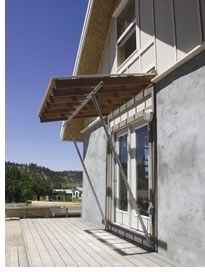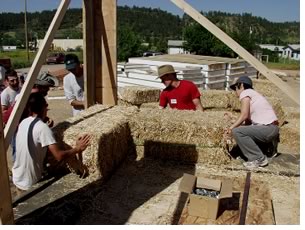

07/2004
REPORT
FROM CONVENTION
American Indian Housing Initiative CES Seminar Raises Concerns
 Of
the diverse continuing education seminars offered at the 2004 AIA National
Convention and Expo in Chicago, I little expected SA07: The American Indian
Housing Initiative to be one of the most contentious programs, but such
it was. Now in its sixth year, the American Indian Housing Initiative
(AIHI) is a partnership among the University of Washington, Penn State,
and Red Feather Development Group with the laudable goal of increasing
the quality and quantity of housing stock and community facilities on
American Indian reservations.
Of
the diverse continuing education seminars offered at the 2004 AIA National
Convention and Expo in Chicago, I little expected SA07: The American Indian
Housing Initiative to be one of the most contentious programs, but such
it was. Now in its sixth year, the American Indian Housing Initiative
(AIHI) is a partnership among the University of Washington, Penn State,
and Red Feather Development Group with the laudable goal of increasing
the quality and quantity of housing stock and community facilities on
American Indian reservations.
For two weeks each summer, the AIHI partnership brings design students, alumni, and cross-disciplinary volunteers to the Northern Cheyenne reservation in Montana to build a needed structure on the reservation. Four homes and an adult education center already have been constructed (two homes were on other reservations), and this summer teams are building a technology center on the campus of Chief Dull Knife College, Lame Deer, Mont., and a sweat lodge in Busby, Mont.
 Straw-bale
construction
Straw-bale
construction
Much of the controversy arose from AIHI’s chosen building method—straw-bale
construction. The financial resources of AIHI are quite limited, as are
resources on the reservation; although wood-frame and straw-bale structures
are nearly equivalent in terms of construction costs, straw-bale construction
yields tremendous labor and life-cycle savings. Straw is energy-efficient
because it provides excellent insulation and doesn’t require a great
deal of maintenance; the labor is cheaper because inexperienced volunteers
can be taught the construction methods quickly and they can be passed
on easily. In addition, the straw bale method encourages community participation
in creating structures of which they can be proud.
 The
intent of AIHI has always been to teach the local tribal community skills
necessary to build and maintain new structures as they are needed, thereby
facilitating employment of American Indian workers and benefiting the
community as a whole. In fact, the focus of the Chief Dull Knife College
Technology Center will be “on construction-skills training and home-repair/home-maintenance
workshops for tribal members.”
The
intent of AIHI has always been to teach the local tribal community skills
necessary to build and maintain new structures as they are needed, thereby
facilitating employment of American Indian workers and benefiting the
community as a whole. In fact, the focus of the Chief Dull Knife College
Technology Center will be “on construction-skills training and home-repair/home-maintenance
workshops for tribal members.”
Critics of the initiative argued that too little is being done to help those on Native American reservations. One attendant argued that, “what you’re doing—building one structure per year—doesn’t make a difference. We need to do more.” He went on to argue that the U.S. government, AIA, non-profit institutions, and universities need to get involved and find a solution to this disgraceful and persistent problem.
A beginning
Few would disagree that the Native American population is in dire need
of serious and sustained economic and social assistance. However, until
all those and additional parties recognize and empathize with the situation
of Native Americans, large-scale change will not occur. The AIHI offers—at
the very least—assistance that is welcomed by the Northern Cheyenne,
an educational and humanitarian experience for the 70+ annual program
alumni, and a stop-gap plan that hopefully will spur future economic development
within the reservation.
 According to
Scott Wing, AIA, Penn State professor and a key player in AIHI, “the
poverty rate on the Northern Cheyenne reservation is 37 percent, unemployment
is 70 percent, and 40 percent of homes are overcrowded and have serious
deficiencies. In addition, most of the homes are HUD homes that are ill-suited
for the climate, which can range from -50° F in the winter to 110°
F in the summer.”
According to
Scott Wing, AIA, Penn State professor and a key player in AIHI, “the
poverty rate on the Northern Cheyenne reservation is 37 percent, unemployment
is 70 percent, and 40 percent of homes are overcrowded and have serious
deficiencies. In addition, most of the homes are HUD homes that are ill-suited
for the climate, which can range from -50° F in the winter to 110°
F in the summer.”
 Although
one member of the audience argued that straw bale housing is aesthetically
unappealing and personally undesirable, the facilities built by AIHI are
culturally appropriate in that they rely heavily on natural materials,
are built for sustainability, are laid out in deference to tribal tradition,
and incorporate tribal artistry into the structures. They are built at
the invitation of the tribal leadership and are respectful of the land,
the climate, and the people. In addition, they work and—more importantly—work
toward an independent future.
Although
one member of the audience argued that straw bale housing is aesthetically
unappealing and personally undesirable, the facilities built by AIHI are
culturally appropriate in that they rely heavily on natural materials,
are built for sustainability, are laid out in deference to tribal tradition,
and incorporate tribal artistry into the structures. They are built at
the invitation of the tribal leadership and are respectful of the land,
the climate, and the people. In addition, they work and—more importantly—work
toward an independent future.
There is no doubt that more needs to be done for American Indians living on reservations, however, I’m glad that there are groups like AIHI out there helping to set things right. From what I observed, the AIHI program generously and conscientiously contributes greatly needed resources to helping an underserved, yet proud and noble, people. And they do so with respect, integrity, dignity, and compassion.
Copyright 2004 The American Institute of Architects.
All rights reserved. Home Page ![]()
![]()
 |
||
|
Photos courtesy of AIHI.
|
||